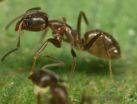(Press-News.org) CINCINNATI – Discovering what they call the "Achilles' heel" for lymphoid leukemia, an international research team has tested a possible alternative treatment that eradicated the disease in mouse models.
Reporting their results Feb. 11 in the journal Cancer Cell, the scientists said the targeted molecular therapy described in their study could have direct implications for current treatment of Acute Lymphoid Leukemia (ALL) in people.
Led by researchers at Cincinnati Children's Hospital Medical Center and the Institut de recherches cliniques de Montreal (ICRM), the study found that leukemic cells depend on a protein called Gfi1 for survival. Removing the protein in mouse models of the disease weakened and killed the leukemia cells. Researchers said this should make the leukemia more susceptible to chemo and radiation therapies – the current frontline treatments for ALL.
"Chemo and radiation therapies are very non-specific and can be toxic to patients. Our findings suggest that combining the inhibition of Gfi1 with these treatments may allow the use of lower cytotoxic doses and directly benefit patients," said H. Leighton Grimes, PhD, co-senior investigator on the study and researcher in the divisions of Cellular and Molecular Immunology and Experimental Hematology at Cincinnati Children's.
Also collaborating was co-senior investigator, Tarik Möröy, PhD, president and scientific director of the ICRM in Montreal.
The researchers said the need for better treatment options is evident. Beside the potential toxicity of current therapeutic options, many ALL patients relapse after initial remission of their disease.
A cancer that affects blood cells and the immune system, ALL is the most common type of leukemia in children from infancy up to age 19, according to the Leukemia and Lymphoma Society of America. ALL occurs most often in the first decade of life but increases in frequency again in older individuals. According to the National Cancer Institute, the overall survival rate for all ages of people with ALL is 66.4 percent and 90.8 percent for children under the age of 5 years.
During the onset of a disease like ALL, cancer signals among cells activate a protein called p53, which is often referred to as the "guardian of the genome." A repressor of tumor growth, p53 normally initiates a DNA repair program that is supposed to induce programmed cell death to stop or slow down tumor progression.
In the case of ALL, the researchers said the disease relies on the Gfi1 protein to get around p53's tumor repressing capabilities by essentially overriding p53. Gfi1 has an important role in the normal development of lymphoid cells. But analyses of ALL mouse models and primary human tumors showed that Gfi1 is overexpressed in the disease state.
When the researchers removed Gfi1 in established mouse lymphoid tumors, the leukemia regressed through p53-induced cell death. Next, to see if removal of Gfi1 would be effective in modeled human ALL, the research team inserted T-cell leukemia cells from human patients into mice. Inhibiting Gfi1 in this instance stopped the progression of human leukemia in the animals without any harmful effects.
The scientists are continuing their research to see if results of the current study will be translatable to human patients.
INFORMATION:
Other collaborators on the study included co-first authors, James Phelan, PhD, a former graduate student in Grimes' laboratory (now a postdoctoral fellow at the National Cancer Institute of the National Institutes of Health), and Cyrus Khandanpour, MD, a former post-doctoral fellow in Dr. Möröy's laboratory (presently a physician scientist at University Hospital of the University of Duisburg-Essen in Germany).
Funding for the research came in part from the National Institutes of Health (grant numbers CA105152, CA159845, P30 DK090971), the Canadian Institutes of Health Research (MOP-84238, MOP-111011) the the Canada Research Chair program, Leukemia and Lymphoma Society of America, CancerFree Kids, Alex's Lemonade Stand, the German Cancer Fund, the Cole Foundation, a University of Cincinnati Cancer Therapeutics T32 training grant (T32-CA117846) and a Pelotonia Fellowship.
About Cincinnati Children's:
Cincinnati Children's Hospital Medical Center ranks third in the nation among all Honor Roll hospitals in U.S. News and World Report's 2012 Best Children's Hospitals ranking. It is ranked #1 for neonatology and in the top 10 for all pediatric specialties. Cincinnati Children's is one of the top two recipients of pediatric research grants from the National Institutes of Health and a research affiliate of the University of Cincinnati College of Medicine. It is internationally recognized for improving child health and transforming delivery of care through fully integrated, globally recognized research, education and innovation. Additional information can be found at www.cincinnatichildrens.org.
END
Researchers who sought to determine whether pricing information for a total hip replacement could be obtained from hospitals and physicians found getting such information was often difficult and that there were wide variations in the quoted prices, according to a report published Online First by JAMA Internal Medicine, a JAMA Network publication.
Data on hospital quality – and to a lesser degree physician quality – are available from public and private sector sources. However, data on hospital and physician pricing are more difficult to obtain, the authors write in the ...
A lack of the protein endoglin in the blood vessels of tumour-bearing mice enables the spread of daughter tumours, according to researchers at Karolinska Institutet and Lund University in Sweden in a study published in the scientific periodical The Journal of Experimental Medicine. Given that the tumour vasculature constitutes an important barrier to the spread of cancer cells, the team suggests that drugs should be developed to strengthen the blood vessels' protective function.
Studies of the process of metastasis (the spread of daughter tumours) have mainly focused ...
On Feb. 9, 2013 at 2:30 a.m. EST, the sun erupted with an Earth-directed coronal mass ejection or CME, associated with a long duration C2.4-class flare. Experimental NASA research models, based on observations from the Solar Terrestrial Relations Observatory (STEREO) and ESA/NASA's Solar and Heliospheric Observatory, show that the CME left the sun at speeds of around 500 miles per second, which is a fairly typical speed for CMEs. Historically, CMEs at this speed are usually benign.
Not to be confused with a solar flare, a CME is a solar phenomenon that can send solar ...
Young adults, in a period of transition, are often reluctant to seek treatment for mental health problems because of the stigma, inadequate insurance coverage and difficulty finding a mental health care provider.
But a new preliminary study by researchers at Case Western Reserve University suggests that depression symptoms may be significantly reduced when 18- to 25-year-olds interact with computerized avatars—virtual 3D images of a healthcare provider like a nurse practitioner or physician —as a way to rehearse office visits ahead of time and learn self-management skills. ...
Researchers from North Carolina State University have found that one of the most aggressive invasive ant species in the United States – the Argentine ant – appears to have met its match in the Asian needle ant. Specifically, the researchers have found that the Asian needle ant is successfully displacing Argentine ants in an urban environment, indicating that the Asian needle ant – with its venomous sting – may be the next invasive species to see a population boom.
In the world of invasive species, the Argentine ant (Linepithema humile) is a success story. Its aggressive, ...
EAST LANSING, Mich. — Children who are bullied online or by mobile phone are just as likely to skip school or consider suicide as kids who are physically bullied, according to a study led by a Michigan State University criminologist.
The findings, published in the International Criminal Justice Review, suggest parents, school officials and policymakers should consider bullying experiences both on and offline when creating anti-bullying policies and procedures.
"We should not ignore one form of bullying for the sake of the other," said Thomas Holt, associate professor ...
In a study to be presented on February 14 between 8 a.m. and 10 a.m. PST, at the Society for Maternal-Fetal Medicine's 33rd annual meeting, The Pregnancy Meeting ™, researchers will report findings that suggest that 17P, a form of progesterone, is not effective in preventing preterm birth among women with twin pregnancies — and may possibly be harmful.
While 17P (17 alpha-hydroxyprogesterone caproate) has been shown to prevent premature delivery among about one-third of women with a singleton pregnancy who have experienced a prior preterm delivery, this latest research ...
By thinking of cells as programmable robots, researchers at Rice University hope to someday direct how they grow into the tiny blood vessels that feed the brain and help people regain functions lost to stroke and disease.
Rice bioengineer Amina Qutub and her colleagues simulate patterns of microvasculature cell growth and compare the results with real networks grown in their lab. Eventually, they want to develop the ability to control the way these networks develop.
The results of a long study are the focus of a new paper in the Journal of Theoretical Biology.
"We ...
In a study to be presented on February 14 between 8 a.m. and 10 a.m. PST, at the Society for Maternal-Fetal Medicine's annual meeting, The Pregnancy Meeting ™, in San Francisco, California, researchers will report findings suggesting an increased risk of early (less than 35 weeks) preterm birth when intra-amniotic debris is present in nulliparous women with a short cervix. The babies born to women with debris had worse outcomes than those born to women without debris, likely due to the earlier delivery.
The multicenter study, presented by Dr. George Saade for the Eunice ...
Organic matter is important for soil health and crop productivity. While an indicator of soil quality, a lot of organic matter is in extremely stable forms, and the nutrients in such forms are difficult for plants to use. The active, labile fraction, however, is a modest but important part of the organic matter.
"The labile fraction is small – usually less than 20 or even 10 percent, depending on how you define it," explains Steve Culman, lead author of a study published online Feb. 8 in Agronomy Journal. "But it is where a lot of the action happens. It's where soil nutrients ...


